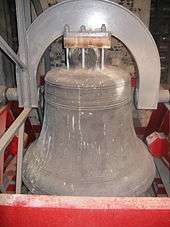Canterbury Cathedral
Canterbury Cathedral in Canterbury, Kent, is one of the oldest and most famous Christian structures in England. It forms part of a World Heritage Site. It is the cathedral of the Archbishop of Canterbury, currently Justin Welby, leader of the Church of England and symbolic leader of the worldwide Anglican Communion. Its formal title is the Cathedral and Metropolitical Church of Christ at Canterbury.
| Canterbury Cathedral | |
|---|---|
| Cathedral and Metropolitical Church of Christ at Canterbury | |
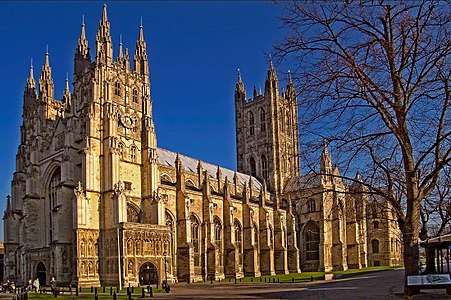 Cathedral from the city entrance | |
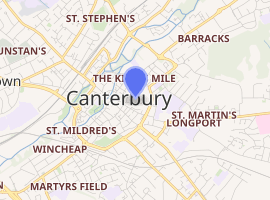
| |
| Location | Canterbury, Kent |
| Country | England |
| Denomination | Church of England |
| Previous denomination | Roman Catholicism |
| Website | canterbury-cathedral.org |
| History | |
| Consecrated | 1070 |
| Architecture | |
| Style | Romanesque, Gothic |
| Years built | 1070 1834 (last major alteration) |
| Specifications | |
| Length | 525 ft (160 m) |
| Nave length | 178 ft (54 m) |
| Choir length | 180 ft (55 m) |
| Width | 154 ft (47 m) |
| Nave width | 71 ft (22 m) |
| Nave height | 80 ft (24 m) |
| Choir height | 71 ft (22 m) |
| Number of towers | 5 |
| Tower height | 236 ft (72 m) (crossing)[1] |
| Number of spires | 1 (now lost) |
| Spire height | 190 ft (58 m) (northwest tower, demolished 1705) |
| Bells | 14 (1981) |
| Tenor bell weight | 34-3-4 (1767kg) |
| Administration | |
| Diocese | Canterbury (since 1072) |
| Province | Canterbury |
| Clergy | |
| Archbishop | Justin Welby, Archbishop of Canterbury |
| Bishop(s) | Rose Hudson-Wilkin, Bishop of Dover |
| Dean | Robert Willis |
| Precentor | Max Kramer (minor canon) |
| Canon(s) | Tim Naish (Librarian) |
| Canon Missioner | Emma Pennington |
| Canon Treasurer | vacant |
| Archdeacon | Jo Kelly-Moore (Canon Residentiary) |
| Laity | |
| Organist/Director of music | David Flood |
| Official name | Canterbury Cathedral, St Augustine's Abbey, and St Martin's Church |
| Type | Cultural |
| Criteria | i, ii, vi |
| Designated | 1988 (12th session) |
| Reference no. | 496 |
| State Party | United Kingdom |
| Region | Europe and North America |
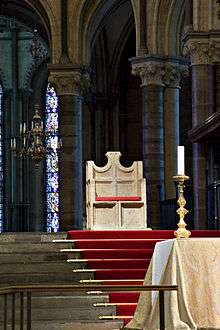
Founded in 597, the cathedral was completely rebuilt between 1070 and 1077. The east end was greatly enlarged at the beginning of the 12th century and largely rebuilt in the Gothic style following a fire in 1174, with significant eastward extensions to accommodate the flow of pilgrims visiting the shrine of Thomas Becket, the archbishop who was murdered in the cathedral in 1170. The Norman nave and transepts survived until the late 14th century when they were demolished to make way for the present structures.
Before the English Reformation the cathedral was part of a Benedictine monastic community known as Christ Church, Canterbury, as well as being the seat of the archbishop.
History
Roman
Christianity had started to become powerful in the Roman Empire around the 3rd century. Following the conversion of Augustine of Hippo in the 4th century, the influence of Christianity grew steadily. The cathedral's first bishop was Augustine of Canterbury, previously abbot of St Andrew's Benedictine Abbey in Rome; when other dioceses were founded in England he was made archbishop. He was sent by Pope Gregory I in 596 as a missionary to the Anglo-Saxons. Augustine founded the cathedral in 597 and dedicated it to Jesus Christ, the Holy Saviour.[2]
Augustine also founded the Abbey of St Peter and Paul outside the city walls. This was later rededicated to St Augustine himself and was for many centuries the burial place of the successive archbishops. The abbey is part of the World Heritage Site of Canterbury, along with the cathedral and the ancient Church of St Martin.[3]
Anglo-Saxon
Bede recorded that Augustine reused a former Roman church. The oldest remains found during excavations beneath the present nave in 1993 were, however, parts of the foundations of an Anglo-Saxon building, which had been constructed across a Roman road.[4][5] They indicate that the original church consisted of a nave, possibly with a narthex, and side-chapels to the north and south. A smaller subsidiary building was found to the south-west of these foundations.[5] During the 9th or 10th century this church was replaced by a larger structure (161 by 75 ft, 49 by 23 m) with a squared west end. It appears to have had a square central tower.[5] The 11th-century chronicler Eadmer, who had known the Saxon cathedral as a boy, wrote that, in its arrangement, it resembled St Peter's in Rome, indicating that it was of basilican form, with an eastern apse.[6]
During the reforms of Dunstan, archbishop from 960 until his death in 988,[7] a Benedictine abbey named Christ Church Priory was added to the cathedral. But the formal establishment as a monastery seems to date only to c. 997 and the community only became fully monastic from Lanfranc's time onwards (with monastic constitutions addressed by him to Prior Henry). Dunstan was buried on the south side of the high altar.
The cathedral was badly damaged during Danish raids on Canterbury in 1011. The Archbishop, Ælfheah, was taken hostage by the raiders and eventually killed at Greenwich on 19 April 1012, the first of Canterbury's five martyred archbishops.[Fn 1] After this a western apse was added as an oratory of Saint Mary, probably during the archbishopric of Lyfing (1013–1020) or Aethelnoth (1020–1038).
The 1993 excavations revealed that the new western apse was polygonal, and flanked by hexagonal towers, forming a westwork. It housed the archbishop's throne, with the altar of St Mary just to the east. At about the same time that the westwork was built, the arcade walls were strengthened and towers added to the eastern corners of the church.[5]
Norman
The cathedral was destroyed by fire in 1067, a year after the Norman Conquest. Rebuilding began in 1070 under the first Norman archbishop, Lanfranc (1070–1077). He cleared the ruins and reconstructed the cathedral to a design based closely on that of the Abbey of Saint-Étienne in Caen, where he had previously been abbot, using stone brought from France.[9] The new church, its central axis about 5m south of that of its predecessor,[5] was a cruciform building, with an aisled nave of nine bays, a pair of towers at the west end, aisleless transepts with apsidal chapels, a low crossing tower, and a short quire ending in three apses. It was dedicated in 1077.[10]

Under Lanfranc's successor Anselm, who was twice exiled from England, the responsibility for the rebuilding or improvement of the cathedral's fabric was largely left in the hands of the priors.[11] Following the election of Prior Ernulf in 1096, Lanfranc's inadequate east end was demolished, and replaced with an eastern arm 198 feet long, doubling the length of the cathedral. It was raised above a large and elaborately decorated crypt. Ernulf was succeeded in 1107 by Conrad, who completed the work by 1126.[12] The new quire took the form of a complete church in itself, with its own transepts; the east end was semicircular in plan, with three chapels opening off an ambulatory.[12] A free-standing campanile was built on a mound in the cathedral precinct in about 1160.[13]
As with many Gothic church buildings, the interior of the quire was richly embellished.[14] William of Malmesbury wrote: "Nothing like it could be seen in England either for the light of its glass windows, the gleaming of its marble pavements, or the many-coloured paintings which led the eyes to the paneled ceiling above."[14]
Though named after the 6th-century founding archbishop, the Chair of St Augustine, the ceremonial enthronement chair of the Archbishop of Canterbury, may date from the Norman period. Its first recorded use is in 1205.
Plantagenet period
Martyrdom of Thomas Becket
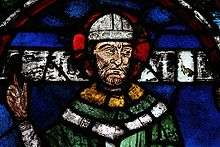
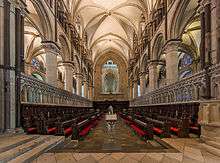
A pivotal moment in the history of the cathedral was the murder of the archbishop, Thomas Becket, in the north-west transept (also known as the Martyrdom) on Tuesday 29 December 1170, by knights of King Henry II. The king had frequent conflicts with the strong-willed Becket and is said to have exclaimed in frustration, "Will no one rid me of this turbulent priest?" Four knights took it literally and murdered Becket in his own cathedral. After the Anglo-Saxon Ælfheah, Becket was the second Archbishop of Canterbury to be murdered.
The posthumous veneration of Becket made the cathedral a place of pilgrimage. This brought both the need to expand the cathedral and the wealth that made it possible.
Rebuilding of the quire
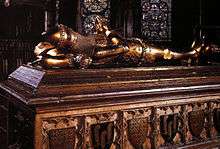
In September 1174 the quire was severely damaged by fire, necessitating a major reconstruction,[15] the progress of which was recorded in detail by a monk named Gervase.[16] The crypt survived the fire intact,[17] and it was found possible to retain the outer walls of the quire, which were increased in height by 12 feet (3.7 m) in the course of the rebuilding, but with the round-headed form of their windows left unchanged.[18] Everything else was replaced in the new Gothic style, with pointed arches, rib vaulting, and flying buttresses. The limestone used was imported from Caen in Normandy, and Purbeck marble was used for the shafting. The quire was back in use by 1180 and in that year the remains of Dunstan and Ælfheah were moved there from the crypt.[19]
The master-mason appointed to rebuild the quire was a Frenchman, William of Sens. Following his injury in a fall from the scaffolding in 1179 he was replaced by one of his former assistants, known as "William the Englishman".[19]
Trinity Chapel and Shrine of Thomas Becket
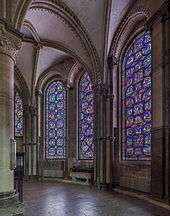
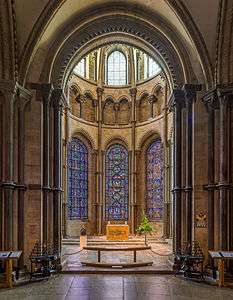
In 1180–4, in place of the old, square-ended, eastern chapel, the present Trinity Chapel was constructed, a broad extension with an ambulatory, designed to house the shrine of St Thomas Becket.[19] A further chapel, circular in plan, was added beyond that, which housed further relics of Becket, [19] widely believed to have included the top of his skull, struck off in the course of his assassination. This latter chapel became known as the "Corona" or "Becket's Crown".[20] These new parts east of the quire transepts were raised on a higher crypt than Ernulf's quire, necessitating flights of steps between the two levels. Work on the chapel was completed in 1184, [19] but Becket's remains were not moved from his tomb in the crypt until 1220.[21] Further significant interments in the Trinity Chapel included those of Edward Plantagenet (The "Black Prince") and King Henry IV.
The shrine in the Trinity Chapel was placed directly above Becket's original tomb in the crypt. A marble plinth, raised on columns, supported what an early visitor, Walter of Coventry, described as "a coffin wonderfully wrought of gold and silver, and marvellously adorned with precious gems".[22] Other accounts make clear that the gold was laid over a wooden chest, which in turn contained an iron-bound box holding Becket's remains.[23] Further votive treasures were added to the adornments of the chest over the years, while others were placed on pedestals or beams nearby, or attached to hanging drapery.[24] For much of the time, the chest (or "feretory") was kept concealed by a wooden cover, which would be theatrically raised by ropes once a crowd of pilgrims had gathered.[21][23] The Dutch humanist Desiderius Erasmus, who visited in 1512–1514, recorded that, once the cover was raised, "the Prior ... pointed out each jewel, telling its name in French, its value, and the name of its donor; for the principal of them were offerings sent by sovereign princes."[25]
The income from pilgrims (such as those portrayed in Geoffrey Chaucer's Canterbury Tales) who visited Becket's shrine, which was regarded as a place of healing, largely paid for the subsequent rebuilding of the cathedral and its associated buildings. This revenue included the profits from the sale of pilgrim badges depicting Becket, his martyrdom, or his shrine.
The shrine was removed in 1538. King Henry VIII summoned the dead saint to court to face charges of treason. Having failed to appear, he was found guilty in his absence and the treasures of his shrine were confiscated, carried away in two coffers and 26 carts.[26]
Monastic buildings

A bird's-eye view of the cathedral and its monastic buildings, made in about 1165[27] and known as the "waterworks plan" is preserved in the Eadwine Psalter in the library of Trinity College, Cambridge.[28] It shows that Canterbury employed the same general principles of arrangement common to all Benedictine monasteries, although, unusually, the cloister and monastic buildings were to the north, rather than the south of the church. There was a separate chapter-house[27] which still exists, said to be "the largest of its kind in all of England". Stained glass here depicts the history of Canterbury.[29]
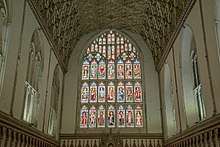
The buildings formed separate groups around the church. Adjoining it, on the north side, stood the cloister and the buildings devoted to the monastic life. To the east and west of these were those devoted to the exercise of hospitality. To the north, a large open court divided the monastic buildings from menial ones, such as the stables, granaries, barn, bakehouse, brewhouse, and laundries, inhabited by the lay servants of the establishment. At the greatest possible distance from the church, beyond the precinct of the monastery, was the eleemosynary department. The almonry for the relief of the poor, with a great hall annexed, formed the paupers' hospitium.[27]
The group of buildings devoted to monastic life included two cloisters. The great cloister was surrounded by the buildings essentially connected with the daily life of the monks: the church to the south, with the refectory placed as always on the side opposite, the dormitory, raised on a vaulted undercroft, and the chapter-house adjacent, and the lodgings of the cellarer, responsible for providing both monks and guests with food, to the west. A passage under the dormitory led eastwards to the smaller or infirmary cloister, appropriated to sick and infirm monks.[27]
The hall and chapel of the infirmary extended east of this cloister, resembling in form and arrangement the nave and chancel of an aisled church. Beneath the dormitory, overlooking the green court or herbarium, lay the "pisalis" or "calefactory", the common room of the monks. At its northeast corner access was given from the dormitory to the necessarium, a building in the form of a Norman hall, 145 feet (44 m) long by 25 feet (7.6 m) broad, containing 55 seats. It was constructed with careful regard to hygiene, with a stream of water running through it from end to end.[27]
A second smaller dormitory for the conventual officers ran from east to west. Close to the refectory, but outside the cloisters, were the domestic offices connected with it: to the north, the kitchen, 47 feet (14 m) square, with a pyramidal roof, and the kitchen court; to the west, the butteries, pantries, etc. The infirmary had a small kitchen of its own. Opposite the refectory door in the cloister were two lavatories, where the monks washed before and after eating.[27]
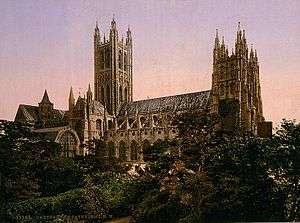
The buildings devoted to hospitality were divided into three groups. The prior's group were "entered at the south-east angle of the green court, placed near the most sacred part of the cathedral, as befitting the distinguished ecclesiastics or nobility who were assigned to him." The cellarer's buildings, where middle-class visitors were entertained, stood near the west end of the nave. The inferior pilgrims and paupers were relegated to the north hall or almonry, just within the gate.[27]
Priors of Christ Church Priory included John of Sittingbourne (elected 1222, previously a monk of the priory) and William Chillenden, (elected 1264, previously monk and treasurer of the priory).[30] The monastery was granted the right to elect their own prior if the seat was vacant by the pope, and – from Gregory IX onwards – the right to a free election (though with the archbishop overseeing their choice). Monks of the priory have included Æthelric I, Æthelric II, Walter d'Eynsham, Reginald fitz Jocelin (admitted as a confrater shortly before his death), Nigel de Longchamps and Ernulf. The monks often put forward candidates for Archbishop of Canterbury, either from among their number or outside, since the archbishop was nominally their abbot, but this could lead to clashes with the king or pope should they put forward a different man – examples are the elections of Baldwin of Forde and Thomas Cobham.

14th and 15th centuries
Early in the 14th century, Prior Eastry erected a stone quire screen and rebuilt the chapter house, and his successor, Prior Oxenden inserted a large five-light window into St Anselm's chapel.[32]
The cathedral was seriously damaged by an earthquake of 1382, losing its bells and campanile.
From the late 14th century the nave and transepts were rebuilt, on the Norman foundations in the Perpendicular style under the direction of the noted master mason Henry Yevele.[33] In contrast to the contemporary rebuilding of the nave at Winchester, where much of the existing fabric was retained and remodeled, the piers were entirely removed, and replaced with less bulky Gothic ones, and the old aisle walls were completely taken down except for a low "plinth" left on the south side.[34][5] More Norman fabric was retained in the transepts, especially in the east walls,[34] and the old apsidal chapels were not replaced until the mid-15th century.[32] The arches of the new nave arcade were exceptionally high in proportion to the clerestory.[32] The new transepts, aisles, and nave were roofed with lierne vaults, enriched with bosses. Most of the work was done during the priorate of Thomas Chillenden (1391–1411): Chillenden also built a new quire screen at the east end of the nave, into which Eastry's existing screen was incorporated.[32] The Norman stone floor of the nave, however, survived until its replacement in 1786.[5]

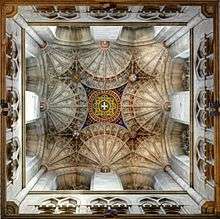
From 1396 the cloisters were repaired and remodeled by Yevele's pupil Stephen Lote who added the lierne vaulting. It was during this period that the wagon-vaulting of the chapter house was created.
A shortage of money and the priority given to the rebuilding of the cloisters and chapterhouse meant that the rebuilding of the west towers was neglected. The south-west tower was not replaced until 1458, and the Norman north-west tower survived until 1834 when it was replaced by a replica of its Perpendicular companion.[32]
In about 1430 the south transept apse was removed to make way for a chapel, founded by Lady Margaret Holland and dedicated to St Michael and All Angels. The north transept apse was replaced by a Lady Chapel, built-in 1448–1455.[32]
The 235-foot (72 m) crossing tower was begun in 1433, although preparations had already been made during Chillenden's priorate when the piers had been reinforced. Further strengthening was found necessary around the beginning of the 16th century when buttressing arches were added under the southern and western tower arches. The tower is often known as the "Angel Steeple", after a gilded angel that once stood on one of its pinnacles.[32]
Modern period
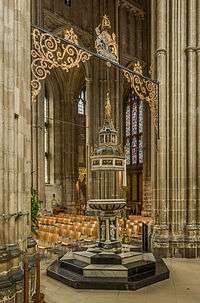
The Reformation, Dissolution and Puritanism
The cathedral ceased to be an abbey during the Dissolution of the Monasteries when all religious houses were suppressed. Canterbury surrendered in March 1539, and reverted to its previous status of 'a college of secular canons'. According to the cathedral's own website, it had been a Benedictine monastery since the 900s. The New Foundation came into being on 8 April 1541.[35] The shrine to St Thomas Becket was destroyed on the orders of Henry VIII and the relics lost.
In 1642–1643, during the English Civil War, Puritan iconoclasts caused significant damage during their "cleansing" of the cathedral.[36] Included in that campaign was the destruction of the statue of Christ in the Christ Church Gate and the demolition of the wooden gates by a group led by Richard Culmer.[37] The statue would not be replaced until 1990 but the gates were restored in 1660 and a great deal of other repair work started at that time; that would continue until 1704.[38][39]
Furnishings
In 1688, the joiner Roger Davis, citizen of London, removed the 13th century misericords and replaced them with two rows of his own work on each side of the quire. Some of Davis's misericords have a distinctly medieval flavour and he may have copied some of the original designs. When Sir George Gilbert Scott carried out renovations in the 19th century, he replaced the front row of Davis' misericords, with new ones of his own design, which seem to include many copies of those at Gloucester Cathedral, Worcester Cathedral and New College, Oxford.

Statues on the West Front
Most of the statues that currently adorn the west front of the cathedral were installed in the 1860s when the South Porch was being renovated. At that time, the niches were vacant and the Dean of the cathedral thought that the appearance of the cathedral would be improved if they were filled. The Victorian sculptor Theodore Pfyffers was commissioned to create the statues and most of them were installed by the end of the 1860s. There are currently 53 statues representing various figures who have been influential in the life of the cathedral and the English church such as clergy, members of the royal family, saints, and theologians. Archbishops of Canterbury from Augustine of Canterbury and Lanfranc, to Thomas Cranmer and William Laud are represented. Kings and Queens from Æthelberht and Bertha of Kent, to Victoria and Elizabeth II are included.[40]
18th century to the present
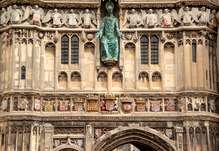
The original towers of Christ Church Gate were removed in 1803 and were replaced in 1937. The statue of Christ was replaced in 1990 with a bronze sculpture of Christ by Klaus Ringwald.[38]
The original Norman northwest tower, which had a lead spire until 1705,[41] was demolished in 1834 owing to structural concerns.[32] It was replaced with a Perpendicular-style twin of the southwest tower (designed by Thomas Mapilton), now known as the "Arundel Tower", providing a more symmetrical appearance for the cathedral.[42][39] This was the last major structural alteration to the cathedral to be made.
In 1866, there were six residentiary canonries, of which one was annexed to the Archdeaconry of Canterbury and another to that of Maidstone.[43] In September 1872, a large portion of the Trinity Chapel roof was completely destroyed by fire. There was no significant damage to the stonework or interior and the damage was quickly repaired.[44]

During the bombing raids of the Second World War its library was destroyed,[45] but the cathedral did not sustain extensive bomb damage; the local Fire Wardens doused any flames on the wooden roof.[46]
In 1986, a new Martyrdom Altar was installed in the northwest transept, on the spot where Thomas Becket was slain, the first new altar in the cathedral for 448 years. Mounted on the wall above it, there is a metal sculpture by Truro sculptor Giles Blomfield depicting a cross flanked by two bloodstained swords which, together with the shadows they cast, represent the four knights who killed Becket. A stone plaque also commemorates Pope John Paul II's visit to the United Kingdom in 1982.[47]
In 2015, Sarah Mullally and Rachel Treweek became the first women to be ordained as bishops in the cathedral, as Bishop of Crediton and Bishop of Gloucester respectively.[48]
The cathedral is the Regimental Church of the Princess of Wales's Royal Regiment. The cathedral is also used as one of the venues for the graduation ceremonies of the University of Kent[49] and Canterbury Christ Church University.[50]
Conservation
Much of the stonework at Canterbury Cathedral is damaged and crumbling, the roofs are leaking and much of the stained glass is badly corroded. The last quinquennial structural review[51] revealed that a combination of centuries of weathering, pollution and constant use had taken its toll on the ancient building and some serious problems were in need of urgent action.
The single biggest challenge is the roof. The cathedral is covered by a huge expanse of lead and whilst the majority of the wooden framework remains sound, much of the lead itself needs replacing. In addition, a large amount of concrete encasing the bottom of the roof beams needs to be removed and replaced with traditional wooden footers.
Conservation of the external masonry, particularly on the northern side of the building, is equally important. The cathedral is in part built of Caen stone. Detailed archaeological studies are undertaken to identify exactly which stones need to be replaced or repaired. In addition, specialist cleaning techniques are used to remove accumulated chemical deposits which are very damaging to the building. As regards the interior, priorities include decoration of the vaults of the Trinity Chapel, major improvements to the Treasury building which contains, amongst other things, the choir practice rooms, and conservation work in several other chapels.
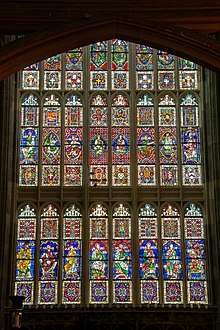
The earliest coloured glass windows in the cathedral date from the late 12th century, whilst others are as new as the four Ervin Bossányi windows in the south-east transept (1957). Many have already been conserved and protected by the team of stained glass conservators led by Leonie Seliger. However, much conservation work remains to be done, notably on the Oculus window in the south-east transept – a late 12th-century round window.[52]
During the autumn of 2008, a major restoration of the lead roof over the transept was completed at a cost of approximately £500,000.[53] In 2018, the lead roof of the nave was replaced.[54] The extensive restoration of the cathedral that was underway in mid-2018 was part of a 2016-2021 schedule that also includes improved landscaping and accessibility, new visitor facilities and a general external restoration.[55] The so-called Canterbury Journey project[56] was expected to cost nearly £25 million; the funding included a £13.8 million Heritage Lottery grant, £10.9 million from by the Canterbury Cathedral Trust and £250,000 from the Friends of the Cathedral.[54]
Foundation
The Foundation is the authorised staffing establishment of the cathedral, few of whom are clergy. The head of the cathedral is the Dean, currently Robert Willis, who is assisted by a chapter of 30 canons, four of whom are residentiary, the others being honorary appointments of senior clergy in the diocese. There are also a number of lay canons who all together form the greater chapter which has the legal responsibility both for the cathedral itself and also for the formal election of an archbishop when there is a vacancy-in-see. By English law and custom, they may only elect the person who has been nominated by the monarch on the advice of the prime minister. The Foundation also includes the choristers, lay clerks, organists, King's Scholars, the Six Preachers and a range of other officers; some of these posts are moribund, such as that of the cathedral barber. The cathedral has a workforce of over 300 (many of whom work part-time), and approximately 800 volunteers.
Dean and Chapter
As of 2 January 2019:[57]
- Dean — Robert Willis (since 1 July 2001)
- Archdeacon of Canterbury and Canon Residentiary — Jo Kelly-Moore (Archdeacon and Canon since 22 January 2017 collation)
- Canon Librarian — Tim Naish (since 22 April 2018)[58]
- Canon Missioner — Emma Pennington (since 16 March 2019)[59]
- Diocesan Canon — vacant since 9 September 2018 (most recently Canon Treasurer and Diocesan director of curates)[60]
The Cathedral uses "Vice Dean" not of one particular appointee, but to refer to the Canon in Residence for each month.[61]
Minor canons:
- Precentor — Max Kramer (since 10 June 2017)[62]
Finance
Canterbury Cathedral receives no government or state funding and only occasional grants from English Heritage. It is not funded by the Church of England. The Church Commissioners pay the salary of the dean and two of the residentiary canons only. The cathedral is therefore largely self-funded.
Around £18,000 is spent each day (2017) on running costs.[63] In order to meet these costs the cathedral has to rely on income from entry fees paid by visitors and a number of commercial operations such as property rental, the Cathedral Shop, as well as the Cathedral Lodge Hotel and Conference Centre.[64]
Appeal
The "Save Canterbury Cathedral" appeal was launched in October 2006 to protect and enhance the cathedral's future as a centre of worship, heritage and culture. The aim was to raise £50 million; by the end of 2010 the appeal had raised £11.5 million,[52] and as at May 2014 over £20 million had been raised.
The core part of the fundraising programme is focused on the cathedral's fabric. The major conservation-restoration projects already identified will cost £30 million. Fabric conservation is the most urgent element of the campaign. The appeal – the third of its kind following major fundraising drives at Canterbury in the 1950s and 1970s – was launched to fund these projects. Fundraising for the appeal will take place over a number of years both nationally and internationally, stressing the cathedral's role as the mother church of the worldwide Anglican Communion and as a World Heritage Site. An integrated conservation programme that addresses the priority areas has been drawn up by the cathedral's Surveyor to the Fabric, John Burton.
Major repair and conservation projects to be funded by the appeal include roofs of the nave, aisles, and North West and South East Transepts; stone carvings, pinnacles and stone facings of the Bell Harry Tower; work on the North side of the Corona Chapel;[52] conservation of the Christ Church Gate entry to the Precincts; conservation of stained glass and surrounding stonework throughout the cathedral; and preservation of the collection of historic books and manuscripts.
In addition, there are plans to refurbish the cathedral pipe organ and renovations to the Choir House have already been completed, providing better facilities for choristers. Improvements are planned to the fabric of the library buildings and to the cathedral's audio-visual and lighting systems which will significantly benefit visitors including the disabled, visually impaired and hard of hearing. The appeal also aims to develop the outmoded workshop area and stained glass studio, in order to ensure the survival of Canterbury as a centre of excellence for vital craft skills and to promote a sustainable maintenance base for work on the cathedral which can be viewed by the public.
The fundraising group is the Canterbury Cathedral Trust, an independent, registered charity (1112590) seeking funds to provide conservation, craftsmanship, music and education. Since mid-2017, the Chief Executive has been Sarah Frankland. The Trust was able to obtain the £24.7m needed for The Canterbury Journey multi-year restoration programme which should be completed in 2021. In 2016/17 the Trust received £3.66m in donations and an additional £1.61m had been pledged for future projects. The next plan was to raise funds to restore and improve the Quire organ by 2020. In 2017, the cathedral was planning to have the new Welcome Centre open in 2019, with exhibition spaces and viewing gallery.[65]
Music
Organ
The organ at Canterbury is of four manuals and is in both south and the north quire aisles, as well as a nave division. It was built in 1886 by Henry Willis and subsequently rebuilt by the same firm in the mid-20th century. It was rebuilt by N. P. Mander in 1978 and reduced to three manuals at about that time. The organ has now been fully restored and greatly enlarged, including reinstating the fourth manual, by Harrison and Harrison with work finishing in February 2020. [66]
Organists
Organists and assistant organists at Canterbury Cathedral have included composers Clement Charlton Palmer, Gerald Hocken Knight and Philip Moore and musical directors Allan Wicks and Stephen Darlington. The current organist and master of the choristers is David Flood and his assistant organist, who is also director of the girls' choir, is David Newsholme.[67] In September 2015, Adrian Bawtree was appointed second assistant organist, a position that replaced the organ scholarship.
Choirs
There has been a choral tradition at Canterbury Cathedral for 1400 years. The cathedral choir consists of 25 boy choristers and 12 lay clerks. The boys are aged eight to thirteen. They receive scholarships and attend St Edmund's School, Canterbury.[67] There are seven choral services a week with Choral Evensong at 5:30 pm on Monday-Friday, with the boys alone on Thursday and men on Wednesday. On Saturday and Sunday, there is evensong at 3:15 pm and Eucharist on Sunday at 11 am. There are numerous extra services, especially at Christmas, Easter, and Pentecost.
The Girls' Choir of Canterbury Cathedral was founded in 2014 and their first performance at Evensong, in January, was attended by more than 600 people and widely covered by the international press.[68][69] They gave their first concert in December of that year.[70] They typically perform at Evensong twice every month, often with the lay clerks of the cathedral choir. The girls are aged 12 to 18. They attend local schools in Canterbury and some further afield.[71]
Bells
The cathedral has a total of 21 bells in the three towers:
The South West Tower (Oxford Tower) contains the cathedral's main ring of bells, hung for change ringing in the English style. There are fourteen bells – a ring of twelve with two semitones, which allow for ringing on ten, eight or six bells while still remaining in tune. All of the bells were cast in 1981 by the Whitechapel Bell Foundry from seven bells of the old peal of twelve with new metal added and rehung in a new frame. The length (draught) of the ropes was increased by lowering the floor of the ringing chamber to the level of the south aisle vault at the same time, also allowing for the new bells to be set lower in the belfry than the old, with the intention of reducing stress on the Medieval structure. The heaviest bell (tenor) of this ring weighs 34 long cwt 3 qr 4 lb (3,896 lb or 1,767 kg).[72] The ringers practise on Thursday at 7:15 pm.
The North West Tower (Arundel Tower) contains the cathedral's clock chime. The five-quarter chimes were taken from the old peal of twelve in the Oxford Tower (where the clock was originally), and hung from beams in the Arundel Tower. The chimes are struck on the eighth Gregorian tone, which is also used at Merton College, Oxford. The hour is struck on Great Dunstan, the largest bell in Kent at 62 long cwt 2 qr 9 lb (7,009 lb or 3,179 kg),[73] which is also swung on Sunday mornings for Matins.
In 1316 Prior Henry of Eastry gave a large bell dedicated to Saint Thomas, which weighed 71 1⁄2 cwt (3,630 kg). Later, in 1343, Prior Hathbrand gave bells dedicated to Jesus and St Dunstan. At this time the bells in campanile were rehung and their names recorded as "Jesus", "Dunstan", "Mary", "Crundale", "Elphy" (Ælfheah) and "Thomas". In the great earthquake of 1382 the campanile fell, destroying the first three named bells. Following its reconstruction, the other three bells were rehung, together with two others, of whose casting no record remains.
The oldest bell in the cathedral is Bell Harry (approximately 8 long cwt (900 lb or 400 kg)[74]), which hangs in a cage on the top of the central tower to which the bell lends its name. This bell was cast by Joseph Hatch in 1635, and is struck at 8 am and 9 pm every day to announce the opening and closing of the cathedral, and also occasionally for services as a Sanctus bell.[75]
The cathedral also has custody of the bell of HMS Canterbury, a World War I-era light cruiser, hung near the Buffs Chapel in the southwest transept.
Library
The cathedral library has a collection of about 30,000 books and pamphlets printed before the 20th century and about 20,000 later books and serials. Many of the earlier books were acquired as part of donated collections. It is rich in church history, older theology, British history (including local history), travel, science and medicine, and the anti-slavery movement. The library's holdings are included in the online catalogue of the library of the University of Kent.[76]
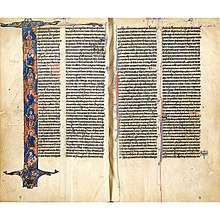
In July 2018, the cathedral purchased at auction a medieval Trussel Bible for £100,000. This bible, subsequently renamed the "Lyghfield Bible", after the monk William Lighfyld, had previously been at Canterbury, being removed following the Dissolution.[77]
See also
- Architecture of the medieval cathedrals of England
- Dean of Canterbury
- Early Gothic architecture
- English Gothic architecture
- List of cathedrals in England
- List of Gothic Cathedrals in Europe
- Prior of Christ Church
- Poor Man's Bible
- Religion in the United Kingdom
References
Footnotes
- Ælfheah is venerated as St Alphege.[8]
Notes
- "A Walk Around Canterbury Cathedral". ParadoxPlace.com. Archived from the original on 3 October 2017. Retrieved 8 December 2017.
- "Canterbury Cathedral- A Virtual Tour". Archived from the original on 28 December 2008. Retrieved 7 October 2008.
- Labadi, Sophia (2013). UNESCO, Cultural Heritage, and Outstanding Universal Value: Value-based Analyses of the World Heritage and Intangible Cultural Heritage Conventions. Rowman & Littlefield. p. 170. ISBN 978-0-759-12256-7.
- "AD 1000 — Canterbury Cathedral". Current Archaeology. Archived from the original on 17 September 2010. Retrieved 16 March 2012.
- Blockley, Kevin; Bennett, Paul. "Canterbury Cathedral". Canterbury Archaeological Trust. Archived from the original on 12 April 2012. Retrieved 12 March 2012.
- Willis 1845, pp. 20–21.
- "St Dunstan (Biographical details)". British Museum. Archived from the original on 14 April 2014. Retrieved 13 April 2014.
- Farmer 1992, pp. 17–18.
- Cook 1949.
- Cook 1949, pp. 19–20.
- Withers 1897, p. 4.
- Cook 1949, p. 19.
- "Campanile mount". Pastscape. English Heritage. Archived from the original on 4 April 2015.
- English Romanesque Art 1066–1200. Catalogue of an Exhibition held at the Hayward Gallery, London, 5 April-8 July 1984. London: Arts Council of Great Britain. 1984. pp. 33–34.
- Cook 1949, p. 23.
- Willis 1845, p. xiv.
- Willis 1845, p. 71.
- Willis 1845, p. 79.
- Cook 1949, pp. 22–23.
- Withers 1897, p. 88–89.
- Withers 1897, p. 8.
- Blick 2005, pp. 407–408.
- Blick 2005, p. 408.
- Blick 2005, p. 424.
- Blick 2005, p. 425.
- Withers 1897, p. 13.
-

- English Romanesque Art 1066–1200. Catalogue of an Exhibition held at the Hayward Gallery, London, 5 April-8 July 1984. London: Arts Council of Great Britain. 1984. p. 374.
- "The Great Cloister and Chapter House of Canterbury Cathedral". Atlas Obscura. Archived from the original on 22 June 2018. Retrieved 30 July 2018.
- Priors of Canterbury Archived 2 December 2008 at the Wayback Machine, Fasti Ecclesiae Anglicanae 1066–1300: volume 2: Monastic Cathedrals (northern and southern provinces; 1971), pp. 8–12
- Withers 1897, p. 64.
- Cook 1949, pp. 43–45.
- Willis 1845, p. 45.
- Willis 1845, p. 121.
- Barrie Dobson, "Canterbury in the Later Middle Ages, 1220–1540", in A History of Canterbury Cathedral, OUP 1995, p. 153.
- Spraggon, Julie (30 July 2018). "Puritan Iconoclasm During the English Civil War". Boydell Press. Archived from the original on 31 July 2018. Retrieved 30 July 2018 – via Google Books.
- "The missing figures in Canterbury's stained glass - Tate". Tate.org.uk. Archived from the original on 12 July 2018. Retrieved 30 July 2018.
- "ccgate - Canterbury History". Canterbury-archaeology.org.uk. Archived from the original on 6 August 2018. Retrieved 30 July 2018.
- "1,400 Years of History". Canterbury-cathedral.org. Archived from the original on 12 July 2018. Retrieved 30 July 2018.
- "Canterbury Cathedral statues honour Queen and Duke". BBC. 27 March 2015. Archived from the original on 31 July 2018. Retrieved 30 July 2018.
- Withers 1897, p. 27.
- "Engineering Timelines - Canterbury Cathedral". Engineering-timelines.com. Archived from the original on 12 July 2018. Retrieved 30 July 2018.
- The Clergy List for 1866 (London: George Cox, 1866) p. 261
- "The fir in the Canterbury Cathedral 1872". Illustrated London News. 14 September 1872. Archived from the original on 4 May 2009. Retrieved 5 December 2014.
- Juergensmeyer, Mark; Roof, Wade Clark (30 July 2018). "Encyclopedia of Global Religion". SAGE. Archived from the original on 31 July 2018. Retrieved 30 July 2018 – via Google Books.
- "The restoration of Canterbury Cathedral". Bbc.co.uk. Archived from the original on 27 October 2018. Retrieved 30 July 2018.
- "Thomas Becket Altar (Martyrdom)". Canterbury Historical & Archaeological Society. Archived from the original on 17 April 2018. Retrieved 2 April 2019.
- First female diocesan bishop in C of E consecrated Archived 6 January 2016 at the Wayback Machine. Anglicannews.org. Retrieved on 23 July 2015.
- "Your graduation day - Congregations - University of Kent". Kent.ac.uk. Archived from the original on 21 October 2017. Retrieved 8 December 2017.
- "Your Graduation Day at Canterbury Cathedral". Canterbury.ac.uk. Archived from the original on 1 January 2018. Retrieved 8 December 2017.
- "Canterbury Cathedral appeal reaches £11.5m". BBC News. 12 December 2010. Archived from the original on 22 November 2018. Retrieved 21 July 2018.
- "Cathedral roof repair work starts". News.bbc.co.uk. 7 September 2008. Archived from the original on 12 July 2018. Retrieved 30 July 2018.
- "Canterbury Cathedral £25 million restoration leaves it like a building site". Kentonline.co.uk. Archived from the original on 12 July 2018. Retrieved 30 July 2018.
- "Physical Works". Canterbury-cathedral.org. Archived from the original on 22 June 2018. Retrieved 30 July 2018.
- "Charting the Journey" (PDF). Canterbury-cathedral.org. 2018. Archived (PDF) from the original on 12 July 2018. Retrieved 30 July 2018.
- "Chapter Members". Archived from the original on 2 January 2020. Retrieved 2 January 2019.
- "A New Canon Librarian For Canterbury". Retrieved 31 May 2018.
- "Archived copy". Archived from the original on 24 September 2018. Retrieved 22 December 2018.CS1 maint: archived copy as title (link)
- Canterbury Cathedral — Senior Positions Archived 6 January 2018 at the Wayback Machine (Accessed 5 January 2018)
- "Did you know?". Canterbury-cathedral.org. Archived from the original on 12 July 2018. Retrieved 30 July 2018.
- "Conference & Meeting Facilities". Canterbury-cathedral.org. Archived from the original on 12 July 2018. Retrieved 30 July 2018.
- "Annual Report" (PDF). Canterbury-cathedral.org. 2017. Archived (PDF) from the original on 12 July 2018. Retrieved 30 July 2018.
- https://www.npor.org.uk/NPORView.html?RI=K01569
- Canterbury Cathedral Choir Archived 6 December 2012 at the Wayback Machine, retrieved 1 March 2013.
- Meikle, James (9 January 2014). "Schoolgirls end Canterbury Cathedral tradition of male-only choral singing". The Guardian. Archived from the original on 8 July 2017. Retrieved 14 December 2016.
- "All-girl choir makes history at Canterbury". Press Association. 26 January 2014. Archived from the original on 6 June 2015. Retrieved 9 December 2014.
- Furness, Hannah (28 November 2014). "First Canterbury Cathedral all-girl choir makes its Christmas concert debut". The Telegraph. Archived from the original on 11 June 2016. Retrieved 5 April 2018.
- Canterbury Cathedral Girls' Choir Archived 18 December 2014 at the Wayback Machine, retrieved 9 December 2014
- Love, Dickon. "Canterbury Cathedral, Oxford Tower". Love's Guide to the Church Bells of Kent. Archived from the original on 27 August 2018. Retrieved 26 August 2018.
- Love, Dickon. "Canterbury Cathedral, Arundel Tower". Love's Guide to the Church Bells of Kent. Archived from the original on 27 August 2018. Retrieved 26 August 2018.
- Love, Dickon. "Canterbury Cathedral, Central Tower". Love's Guide to the Church Bells of Kent. Archived from the original on 27 August 2018. Retrieved 26 August 2018.
- Stahlschmidt 1887, pp. 192, 195
- "History and heritage; Library". Canterbury Cathedral. Archived from the original on 14 September 2010.
- Media, ATG. "Medieval bible bought at auction to return to Canterbury Cathedral after 500 years away". Antiques Trade Gazette. Archived from the original on 2 August 2018. Retrieved 2 August 2018.
![]()
Bibliography
- Babington, Margaret (1955), The Romance of Canterbury Cathedral, Raphael Tuck
- Blick, Sarah (2005), "Reconstructing the Shrine of St. Thomas Becket, Canterbury Cathedral", in Blick, Sarah; Tekippe, Rita (eds.), Art and architecture of late medieval pilgrimage in Northern Europe and the British Isles, Leiden and Boston: Brill
- Collinson, Patrick; Ramsay, Nigel; Sparks, Margaret, eds. (2002) [1995], A History of Canterbury Cathedral (revised ed.), Oxford University Press, ISBN 0-19-820051-X
- Cook, G. H. (1949), Portrait of Canterbury Cathedral, London: Phoenix House
- Farmer, David Hugh (1992), The Oxford Dictionary of Saints (3rd ed.), Oxford University Press, ISBN 0-19-283069-4
- Iremonger, F. A. (1948), William Temple, Archbishop of Canterbury — his life and letters, Oxford University Press
- Purcell, William (1969), Fisher of Lambeth: a portrait from life, Hodder and Stoughton, ISBN 0-340-02938-2
- Stahlschmidt, J. C. L. (1887), The Church Bells of Kent: Their Inscriptions, Founders, Uses and Traditions, Elliot Stock, OCLC 12772194
- Willis, Robert (1845), The Architectural History of Canterbury Cathedral, London: Longman
- Withers, Hartley (1897), The Cathedral Church of Canterbury, Bell's Cathedral Series (2nd revised ed.), London: George Bell
Further reading
- Butler, John (2011), The Red Dean of Canterbury: the Public and Private Faces of Hewlett Johnson, Scala Publishing, ISBN 1857597362
- Best, Nicholas (2019), Bell Harry, Endeavour Media
- Foyle, Jonathan (2013), The Architecture of Canterbury Cathedral, Scala Arts and Heritage Publishers, ISBN 978-1857597011
- Guy, John (2012), Thomas Becket: Warrior, Priest, Rebel, Random House, ISBN 1400069076
- Keates, Jonathan & Hornak, Angelo (2013), Canterbury Cathedral, Scala Arts and Heritage Publishers, ISBN 978-1857590272
- Michael, M. A. (2004), The Stained Glass of Canterbury Cathedral, Scala Arts and Heritage Publishers, ISBN 978-1857593655
- Newman, John (2013), Pevsner's Buildings of England, Kent: North and North East, New Haven: Yale University Press, ISBN 9780300185065
- Rudolph, Conrad, "The Parabolic Discourse Window and the Canterbury Roll: Social Change and the Assertion of Elite Status at Canterbury Cathedral," Oxford Art Journal 38 (2015) 1-19
- Sparks, Margaret (2007), Canterbury Cathedral Precincts: an historical survey, Canterbury: Dean & Chapter of Canterbury, ISBN 978-0950139203
- Sparks, Margaret & Brayshaw, Karen (2011) The Library of Canterbury Cathedral. Canterbury: Friends of Canterbury Cathedral, ISBN 978-0-906211-63-2
- Weaver, Jeffrey (2013) The Ancestors of Christ Windows at Canterbury Cathedral. Los Angeles: Getty Publications, ISBN 978-1-60606-146-6
- Withers, Hartley (1908) [1896]. The Cathedral Church of Canterbury: A Description of Its Fabric and a Brief History of the Archiepiscopal See. Bell.
- Woolnoth, William (1816). A graphical illustration of the metropolitan cathedral church of Canterbury: accompanied by a history and description ... of that venerable fabric ... Also comprising biographical sketches of the lives of the archbishops, and deans of Canterbury; and historical notices of the celebrated Convent of Christchurch ... T. Cadell and W. Davies.
External links
| Wikimedia Commons has media related to Canterbury Cathedral. |

